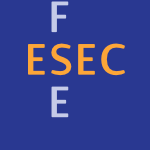34 papers:
 ESEC-FSE-2015-EichbergHMG
ESEC-FSE-2015-EichbergHMG- Hidden truths in dead software paths (ME, BH, MM, LG), pp. 474–484.
 CSL-2015-GradelP #exclamation #logic #rank
CSL-2015-GradelP #exclamation #logic #rank- Rank Logic is Dead, Long Live Rank Logic! (EG, WP), pp. 390–404.
 SCSM-2014-LopesMP #analysis #social #web
SCSM-2014-LopesMP #analysis #social #web- Virtual Homage to the Dead: An Analysis of Digital Memorials in the Social Web (ADL, CM, VCP), pp. 67–78.
 HPCA-2014-AhnYC #architecture #named #predict
HPCA-2014-AhnYC #architecture #named #predict- DASCA: Dead Write Prediction Assisted STT-RAM Cache Architecture (JA, SY, KC), pp. 25–36.
 OOPSLA-2013-SalkeldK
OOPSLA-2013-SalkeldK- Interacting with dead objects (RS, GK), pp. 203–216.
 CSMR-2012-DavisGHMM #assembly #experience #industrial
CSMR-2012-DavisGHMM #assembly #experience #industrial- Analyzing Assembler to Eliminate Dead Functions: An Industrial Experience (IJD, MWG, RCH, SM, NM), pp. 467–470.
 ICSM-2012-BoomsmaHG #industrial #lessons learnt #php #web
ICSM-2012-BoomsmaHG #industrial #lessons learnt #php #web- Dead code elimination for web systems written in PHP: Lessons learned from an industry case (HB, BVH, HGG), pp. 511–515.
 CGO-2012-ChabbiM #named
CGO-2012-ChabbiM #named- DeadSpy: a tool to pinpoint program inefficiencies (MC, JMMC), pp. 124–134.
 VLDB-2011-HaasMST #modelling
VLDB-2011-HaasMST #modelling- Data is Dead... Without What-If Models (PJH, PPM, PGS, WCT), pp. 1486–1489.
 ICSE-2010-GenevesL #source code #xquery
ICSE-2010-GenevesL #source code #xquery- Eliminating dead-code from XQuery programs (PG, NL), pp. 305–306.
 CGO-2010-Zorn #exclamation #performance
CGO-2010-Zorn #exclamation #performance- Performance is dead, long live performance! (BGZ), p. 1.
 HT-2009-MorishimaNISK #approach #lessons learnt
HT-2009-MorishimaNISK #approach #lessons learnt- Bringing your dead links back to life: a comprehensive approach and lessons learned (AM, AN, TI, SS, HK), pp. 15–24.
 CASE-2007-McVittieSMMLHM #automation #classification #using
CASE-2007-McVittieSMMLHM #automation #classification #using- Automated Classification of Macrophage Membrane Integrity using a Fluorescent Live/Dead Stain (PM, CSS, TWM, SM, MEL, MH, DRM), pp. 554–559.
 DAC-2006-BorkarBCNSS #question
DAC-2006-BorkarBCNSS #question- Tomorrow’s analog: just dead or just different? (SYB, RWB, JHC, EN, DS, CS), pp. 709–710.
 PEPM-2006-LewisJ #analysis #model checking
PEPM-2006-LewisJ #analysis #model checking- A dead variable analysis for explicit model checking (ML, MJ), pp. 48–57.
 SAC-2006-ChongL #using
SAC-2006-ChongL #using- An extension of dead end elimination for protein side-chain conformation using merge-decoupling (KFC, HWL), pp. 195–199.
 SEFM-2005-BlechGG #higher-order #verification
SEFM-2005-BlechGG #higher-order #verification- Formal Verification of Dead Code Elimination in Isabelle/HOL (JOB, LG, SG), pp. 200–209.
 CC-2004-CaiGX
CC-2004-CaiGX- Region-Based Partial Dead Code Elimination on Predicated Code (QC, LG, JX), pp. 150–166.
 SCAM-J-2001-ChenXYZ02 #ada #concurrent #detection
SCAM-J-2001-ChenXYZ02 #ada #concurrent #detection- Concurrent Ada dead statements detection (ZC, BX, HY, JZ), pp. 733–741.
 ASPLOS-2002-ButtsS #detection
ASPLOS-2002-ButtsS #detection- Dynamic dead-instruction detection and elimination (JAB, GSS), pp. 199–210.
 SCAM-2001-ChenXY #concurrent #detection #source code
SCAM-2001-ChenXY #concurrent #detection #source code- Detecting Dead Statements for Concurrent Programs (ZC, BX, HY), pp. 67–74.
 SIGAda-2001-EhresmanF
SIGAda-2001-EhresmanF- Electronic maneuvering board and dead reckoning tracer decision aid for the officer of the deck (KLE, JLF), pp. 61–70.
 ICLP-2001-Kowalski #logic #question
ICLP-2001-Kowalski #logic #question- Is Logic Really Dead or Only Just Sleeping? (RAK), pp. 2–3.
 SAS-1999-LiuS #recursion
SAS-1999-LiuS #recursion- Eliminating Dead Code on Recursive Data (YAL, SDS), pp. 211–231.
 SAS-1999-TakimotoH #graph #using
SAS-1999-TakimotoH #graph #using- Partial Dead Code Elimination Using Extended Value Graph (MT, KH), pp. 179–193.
 PADL-1999-Xi #dependent type
PADL-1999-Xi #dependent type- Dead Code Elimination through Dependent Types (HX), pp. 228–242.
 PLDI-1998-SweeneyT #c++ #case study
PLDI-1998-SweeneyT #c++ #case study- A Study of Dead Data Members in C++ Applications (PFS, FT), pp. 324–332.
 SIGAda-1998-MacosM
SIGAda-1998-MacosM- The Rendezvous is Dead — Long Live the Protected Object (DM, FM), pp. 287–293.
 TOOLS-USA-1998-Taylor
TOOLS-USA-1998-Taylor- Objects are Dead — Long Live Agents (DAT), p. 4.
 HT-1997-Smith
HT-1997-Smith- The King is Dead; Long Live the King (Keynote) (JBS), p. 240.
 PLDI-1997-BodikG #slicing #using
PLDI-1997-BodikG #slicing #using- Partial Dead Code Elimination using Slicing Transformations (RB, RG), pp. 159–170.
 ESEC-FSE-1997-ChenGK #analysis #c++ #detection #reachability
ESEC-FSE-1997-ChenGK #analysis #c++ #detection #reachability- A C++ Data Model Supporting Reachability Analysis and Dead Code Detection (YFC, ERG, EK), pp. 414–431.
 PLDI-1994-KnoopRS
PLDI-1994-KnoopRS- Partial Dead Code Elimination (JK, OR, BS), pp. 147–158.
 SIGIR-1993-BooksteinKR #question
SIGIR-1993-BooksteinKR #question- Is Huffman Coding Dead? (AB, STK, TR), pp. 80–87.
 ESEC-FSE-2015-EichbergHMG
ESEC-FSE-2015-EichbergHMG CSL-2015-GradelP #exclamation #logic #rank
CSL-2015-GradelP #exclamation #logic #rank SCSM-2014-LopesMP #analysis #social #web
SCSM-2014-LopesMP #analysis #social #web HPCA-2014-AhnYC #architecture #named #predict
HPCA-2014-AhnYC #architecture #named #predict OOPSLA-2013-SalkeldK
OOPSLA-2013-SalkeldK CSMR-2012-DavisGHMM #assembly #experience #industrial
CSMR-2012-DavisGHMM #assembly #experience #industrial ICSM-2012-BoomsmaHG #industrial #lessons learnt #php #web
ICSM-2012-BoomsmaHG #industrial #lessons learnt #php #web CGO-2012-ChabbiM #named
CGO-2012-ChabbiM #named VLDB-2011-HaasMST #modelling
VLDB-2011-HaasMST #modelling ICSE-2010-GenevesL #source code #xquery
ICSE-2010-GenevesL #source code #xquery CGO-2010-Zorn #exclamation #performance
CGO-2010-Zorn #exclamation #performance HT-2009-MorishimaNISK #approach #lessons learnt
HT-2009-MorishimaNISK #approach #lessons learnt CASE-2007-McVittieSMMLHM #automation #classification #using
CASE-2007-McVittieSMMLHM #automation #classification #using DAC-2006-BorkarBCNSS #question
DAC-2006-BorkarBCNSS #question PEPM-2006-LewisJ #analysis #model checking
PEPM-2006-LewisJ #analysis #model checking SAC-2006-ChongL #using
SAC-2006-ChongL #using SEFM-2005-BlechGG #higher-order #verification
SEFM-2005-BlechGG #higher-order #verification CC-2004-CaiGX
CC-2004-CaiGX SCAM-J-2001-ChenXYZ02 #ada #concurrent #detection
SCAM-J-2001-ChenXYZ02 #ada #concurrent #detection ASPLOS-2002-ButtsS #detection
ASPLOS-2002-ButtsS #detection SCAM-2001-ChenXY #concurrent #detection #source code
SCAM-2001-ChenXY #concurrent #detection #source code SIGAda-2001-EhresmanF
SIGAda-2001-EhresmanF ICLP-2001-Kowalski #logic #question
ICLP-2001-Kowalski #logic #question SAS-1999-LiuS #recursion
SAS-1999-LiuS #recursion SAS-1999-TakimotoH #graph #using
SAS-1999-TakimotoH #graph #using PADL-1999-Xi #dependent type
PADL-1999-Xi #dependent type PLDI-1998-SweeneyT #c++ #case study
PLDI-1998-SweeneyT #c++ #case study SIGAda-1998-MacosM
SIGAda-1998-MacosM TOOLS-USA-1998-Taylor
TOOLS-USA-1998-Taylor HT-1997-Smith
HT-1997-Smith PLDI-1997-BodikG #slicing #using
PLDI-1997-BodikG #slicing #using ESEC-FSE-1997-ChenGK #analysis #c++ #detection #reachability
ESEC-FSE-1997-ChenGK #analysis #c++ #detection #reachability PLDI-1994-KnoopRS
PLDI-1994-KnoopRS SIGIR-1993-BooksteinKR #question
SIGIR-1993-BooksteinKR #question









